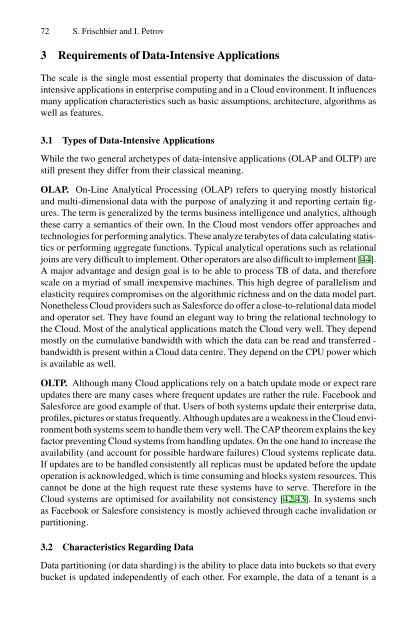Aspects of Data-Intensive Cloud Computing - DVS - Technische ...
Aspects of Data-Intensive Cloud Computing - DVS - Technische ...
Aspects of Data-Intensive Cloud Computing - DVS - Technische ...
Create successful ePaper yourself
Turn your PDF publications into a flip-book with our unique Google optimized e-Paper software.
72 S. Frischbier and I. Petrov<br />
3 Requirements <strong>of</strong> <strong>Data</strong>-<strong>Intensive</strong> Applications<br />
The scale is the single most essential property that dominates the discussion <strong>of</strong> dataintensive<br />
applications in enterprise computing and in a <strong>Cloud</strong> environment. It influences<br />
many application characteristics such as basic assumptions, architecture, algorithms as<br />
well as features.<br />
3.1 Types <strong>of</strong> <strong>Data</strong>-<strong>Intensive</strong> Applications<br />
While the two general archetypes <strong>of</strong> data-intensive applications (OLAP and OLTP) are<br />
still present they differ from their classical meaning.<br />
OLAP. On-Line Analytical Processing (OLAP) refers to querying mostly historical<br />
and multi-dimensional data with the purpose <strong>of</strong> analyzing it and reporting certain figures.<br />
The term is generalized by the terms business intelligence und analytics, although<br />
these carry a semantics <strong>of</strong> their own. In the <strong>Cloud</strong> most vendors <strong>of</strong>fer approaches and<br />
technologies for performing analytics. These analyze terabytes <strong>of</strong> data calculating statistics<br />
or performing aggregate functions. Typical analytical operations such as relational<br />
joins are very difficult to implement. Other operators are also difficult to implement [44].<br />
A major advantage and design goal is to be able to process TB <strong>of</strong> data, and therefore<br />
scale on a myriad <strong>of</strong> small inexpensive machines. This high degree <strong>of</strong> parallelism and<br />
elasticity requires compromises on the algorithmic richness and on the data model part.<br />
Nonetheless <strong>Cloud</strong> providers such as Salesforce do <strong>of</strong>fer a close-to-relational data model<br />
and operator set. They have found an elegant way to bring the relational technology to<br />
the <strong>Cloud</strong>. Most <strong>of</strong> the analytical applications match the <strong>Cloud</strong> very well. They depend<br />
mostly on the cumulative bandwidth with which the data can be read and transferred -<br />
bandwidth is present within a <strong>Cloud</strong> data centre. They depend on the CPU power which<br />
is available as well.<br />
OLTP. Although many <strong>Cloud</strong> applications rely on a batch update mode or expect rare<br />
updates there are many cases where frequent updates are rather the rule. Facebook and<br />
Salesforce are good example <strong>of</strong> that. Users <strong>of</strong> both systems update their enterprise data,<br />
pr<strong>of</strong>iles, pictures or status frequently. Although updates are a weakness in the <strong>Cloud</strong> environment<br />
both systems seem to handle them very well. The CAP theorem explains the key<br />
factor preventing <strong>Cloud</strong> systems from handling updates. On the one hand to increase the<br />
availability (and account for possible hardware failures) <strong>Cloud</strong> systems replicate data.<br />
If updates are to be handled consistently all replicas must be updated before the update<br />
operation is acknowledged, which is time consuming and blocks system resources. This<br />
cannot be done at the high request rate these systems have to serve. Therefore in the<br />
<strong>Cloud</strong> systems are optimised for availability not consistency [42,43]. In systems such<br />
as Facebook or Salesfore consistency is mostly achieved through cache invalidation or<br />
partitioning.<br />
3.2 Characteristics Regarding <strong>Data</strong><br />
<strong>Data</strong> partitioning (or data sharding) is the ability to place data into buckets so that every<br />
bucket is updated independently <strong>of</strong> each other. For example, the data <strong>of</strong> a tenant is a















